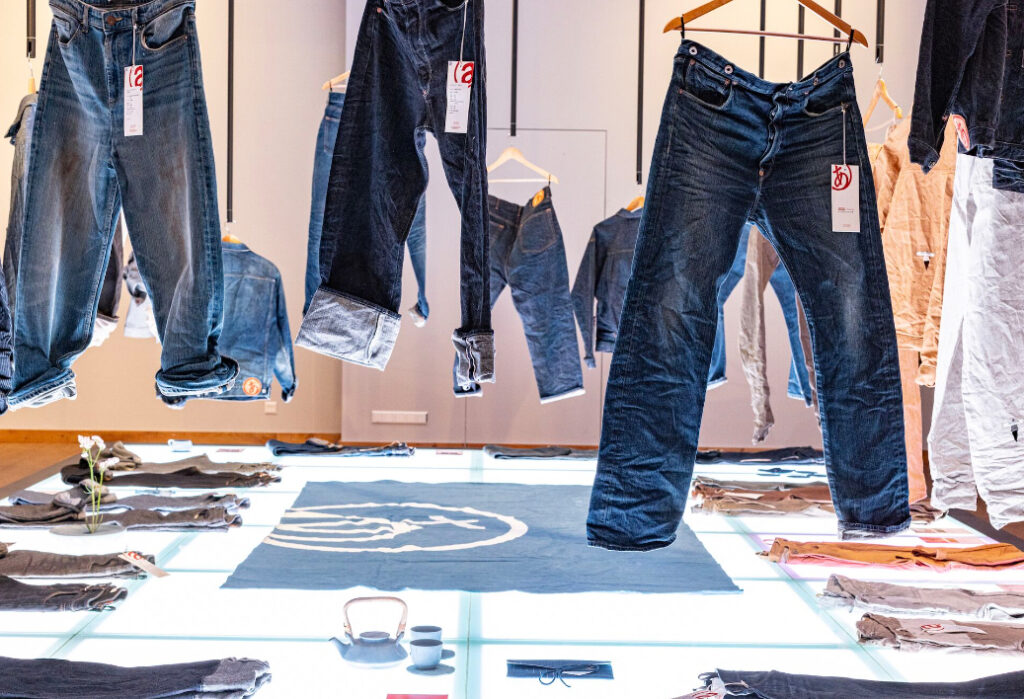
Yesterday afternoon, the corridors of Amsterdam’s Fashion for Good HQ buzzed with an energy that only true collaboration can generate. The occasion? An exclusive preview of Arvind Limited’s Japanese-designed denim collection, co-created with DrDenim. As select guests stepped into the venue, they weren’t merely entering a showroom—they were entering a new era of denim craftsmanship, one that honors tradition while boldly stepping into the future.
This wasn’t just a product showcase. It was a meeting of minds, a creative convergence between India’s textile powerhouse and Japan’s revered design discipline, presented in a space committed to reshaping fashion’s trajectory. With executives, innovators, and change agents gathered under one roof, the event marked more than just a launch—it was a manifesto for a resilient and responsible fashion industry.
Arvind Limited: A Legacy Recast for Tomorrow
With over nine decades of heritage, Arvind Limited is no stranger to denim. The company has been at the forefront of fabric innovation, spearheading revolutions in sustainable manufacturing, textile technology, and circularity. Yet with this latest collection, Arvind demonstrates that it is still restless, still reimagining, and still unafraid to experiment.
Led by Abhishek Bansal, Rajesh Gupta, Nitesh Dhingra, and Karan Ojha, Arvind’s team brought not only technical mastery but also deep industry insight into the collaboration. As guests browsed the collection, many remarked on the seamless integration of Japanese minimalism with Arvind’s denim heritage, resulting in pieces that were at once tactile and conceptual.
A Fusion with DrDenim: Tailored Precision Meets Scalable Craft
The involvement of DrDenim was essential to this capsule’s success. Known for its research-driven approach to denim design, the Swedish-founded, Japanese-influenced label brought a rigorous aesthetic philosophy into the project. Every seam, every wash, every fiber was considered with surgical intent.
Rather than produce garments that merely looked different, the collaboration sought to question the very structure of denim—how it’s woven, finished, worn, and recycled. The silhouettes spoke of restraint, but the fabrics whispered of layers of experimentation. Coated finishes, indigo gradients, raw selvedge lines, and reverse-weave constructions played together to challenge the viewer’s expectations.
The Collection: Indigo as Art, Fabric as Language
Unveiled in a minimalist gallery setup curated within the HQ, the collection focused on textile innovation, silhouette restraint, and sustainable ambition. Pieces ranged from structured kimono-inspired jackets to soft, slouchy trousers with asymmetrical seams. Boxy shirts featured exposed stitchwork, while denim scarves explored the boundaries between function and flair.
What tied the collection together was a color story rooted in indigo—not just as a hue, but as a medium. Some fabrics embraced deep, inky saturation, while others showed signs of intentional fading and wear, alluding to Japanese boro repair traditions. Washes were developed using low-water and enzyme-based processes, demonstrating Arvind’s continued push toward planet-positive manufacturing.
The real showstopper? A modular unisex denim coat with removable panels, each stitched using contrasting Japanese sashiko techniques. Not only did it serve as a design centerpiece, but it was also fully traceable via QR coding, linking buyers to the garment’s full lifecycle and material provenance.
Behind the Scenes: Who Made It Happen
A gathering of minds this impactful doesn’t materialize overnight. The success of the event hinged on the hard work and vision of key figures across Arvind and Fashion for Good, including Meghan Sweeney Langston from the Arvind Denim Lab and Eva Engelen from Fashion for Good.
Also present were Priyanka Khanna, Dagmar Grote, Hollie Stringer, and Iro Kofokotsiou, each bringing invaluable perspective from their respective areas of sustainability, fashion curation, and innovation leadership.
Their contributions stretched from curation and narrative to logistics and outreach, ensuring the event resonated beyond fabric and fit. They helped shape the story that this denim tells: one of transcultural synergy, purposeful design, and a shared roadmap toward regenerative fashion.
A Space Designed for Change
The choice to host the preview at Fashion for Good HQ wasn’t arbitrary. As the world’s first museum and innovation platform dedicated to sustainable fashion, the HQ provided more than just a venue—it provided context and credibility.
Against a backdrop of interactive exhibitions, traceable textile samples, and digital installations, Arvind’s new denim line found its natural habitat. Displayed on raw wood fixtures and recycled mannequins, the garments sat among educational placards that detailed carbon metrics, water footprints, and biodegradable finishes.
This framing encouraged visitors to consider not just the garments themselves, but the systems and ethics behind their creation.
Beyond the Preview: A Look Toward Circularity
While the collection is limited in quantity, its implications are vast. Arvind has hinted that the innovations piloted here—new bio-based dyes, closed-loop cellulose blends, and waterless finishing techniques—will soon be scaled across its broader production network.
This reflects a growing trend among global manufacturers: to test sustainability within high-design capsules before introducing these solutions at scale. For Arvind, this strategy reinforces their commitment not just to storytelling, but to systemic impact.
As Abhishek Bansal noted during the closing Q&A, “Innovation doesn’t matter unless it’s scalable. This isn’t just denim—it’s a prototype for the future of global textile ecosystems.”
The Power of Collective Vision
What made the afternoon feel especially rare was the sense of mutual accountability in the room. Executives weren’t there to boast. Designers weren’t there just to showcase. Everyone present—from fiber technologists to fashion buyers—spoke of the need for realignment, rethinking, and repair in how fashion operates.
There was an almost electric recognition that collaboration like this—between industry veterans and experimental labels, across continents and value chains—is the only path forward. And for once, the talk didn’t feel performative. It felt urgent. It felt real.
Audience Response: Intimate, Insightful, Inspired
While the event was invite-only, the crowd brought global perspective. Attendees included circular fashion scholars, regenerative cotton suppliers, product designers, and press. The tone was equal parts celebratory and strategic. People weren’t just admiring the clothes—they were asking hard questions about end-of-life, repairability, and transparency.
The most commented-on aspect? The unexpected gentleness of the denim. Despite its rich color and complex construction, nearly every attendee touched the pieces and remarked on how light and breathable they felt. That fusion of comfort, performance, and narrative is precisely what made the collection so impactful.
Capturing the Moment: Through the Eyes of the Lens
No story is complete without documentation, and photographers James SG Gallagher and Konstantin Sonnenkind captured the day’s atmosphere with sharp editorialism. Their images—of draped denim jackets under skylight, of handshakes between old collaborators, of smiles over fabric swatches—will no doubt serve as lasting archives of an afternoon that redefined what fashion previews could be.
Expect to see their work featured across campaign visuals, media packages, and sustainability documentation from both Arvind and Fashion for Good in the coming weeks.
Impression
If the Arvind x DrDenim collection preview proved anything, it’s that denim is far from done. In the right hands, this most storied of fabrics can still surprise, still evolve, still challenge our assumptions. When backed by innovation labs, sustainability leadership, and cross-cultural collaboration, even the simplest textile can spark meaningful change.
As attendees filed out, some holding postcards with QR-linked collection specs, others exchanging ideas about cotton regeneration and future dye innovation, the consensus was clear: this wasn’t just a product launch. It was a blueprint for fashion’s forward motion.
No comments yet.









